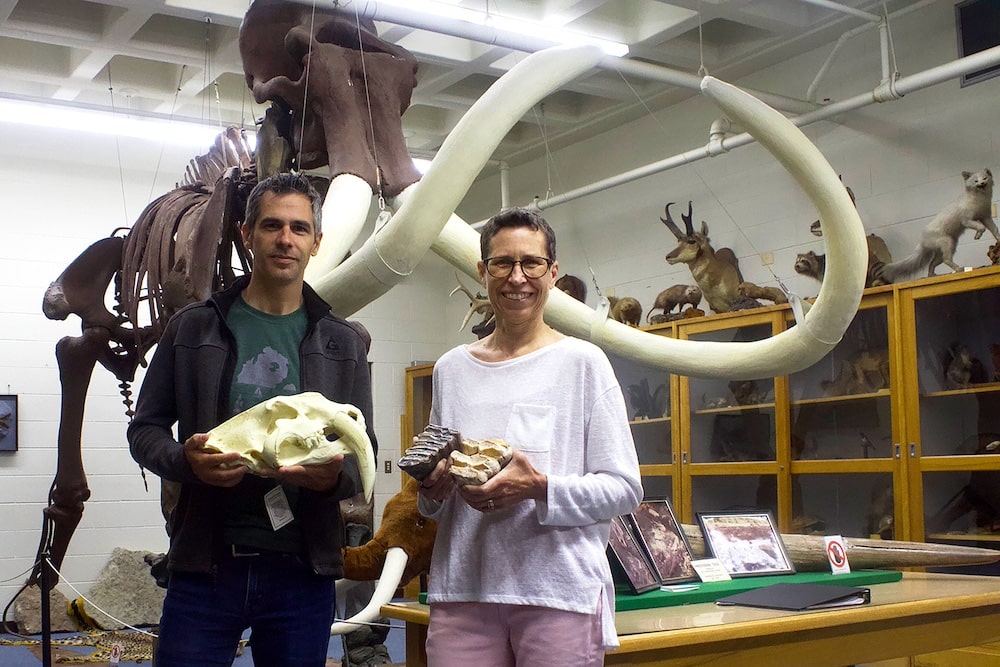Andrews University Museum of Nature & Science Reveals New Plans
They include greater community participation, collaboration, and development.
October 4, 2023 | Berrien Springs, Michigan, United States | Nicholas Gunn, for Andrews University, and Adventist Review
The Andrews University Museum of Nature & Science, formerly known as The Andrews University Museum of Natural History, has remained primarily unchanged in the 61 years since its inception in 1962. The museum, located in Berrien Springs, Michigan, United States, began as a collection of donated specimens used for teaching in the Biology Department but expanded when space was set aside following the completion of the university’s Science Complex in the early 1970s.

Daniel Gonzalez-Socoloske and Roshelle Hall hold specimens while standing in front of the “Prillwitz Mammoth,” the most complete Columbian Mammoth found in the state of Michigan. [Photo: Nicholas Gunn]
One of the major recent changes in the museum was the addition of Roshelle Hall as adjunct assistant curator. Since taking the position in January of 2022, Hall has been working alongside curator and professor of biology Daniel Gonzalez-Socoloske to improve various aspects of the museum and community engagement.
Born and raised in Southern California, Hall had a fascination from an early age with animals and the natural world, which led her to pursue undergraduate studies in biology with an emphasis in zoology at La Sierra University.
Hall came to Andrews University after her husband was hired as a faculty member, which prompted her to explore volunteer opportunities at the university’s museum and Biology Department, reigniting her love for research, education, and science. Having a passion for reptiles dating back to her years at La Sierra University, Hall joined the lab of Gonzalez-Socoloske to pursue a master’s degree, studying the endangered eastern massasauga rattlesnake in Berrien County. After completing her master’s in 2019, Hall continued to be involved in the department by volunteering in the museum. Hall and Gonzalez-Socoloske began to reimagine the museum’s potential.
The team is currently working on a three-pronged strategy for the Andrews University Museum of Nature & Science, including greater community participation and engagement, scientific collaboration, and academic development.
Hall and Gonzalez-Socoloske agree that community engagement is a critical component of their museum development plan. “We’re always thinking of new ways to connect with our community,” Gonzalez-Socoloske said. “To connect with our community on a deeper level, we will be revamping displays, putting a much more concerted effort into labeling specimens, and setting up thematic displays. We also want to be much more intentional about our outreach programs that are anchored in the museum’s mission, which is environmental education.”
The museum also intends to become a working museum that actively promotes scientific research. Hall emphasized the necessity of correctly categorizing specimens and making them accessible via internet databases, allowing scholars to obtain critical data without physically visiting the museum. This effort will improve collaboration among scientists around the world and help biodiversity research. “In discussions with other universities, they’re excited to hear what we are planning to do with developing our online database of our unique specimens,” Hall explained.
The museum seeks to enrich Andrews University’s curriculum by serving as a resource for various courses such as biology, art, design, and education. Both Hall and Gonzalez-Socoloske believe that museum specimens and the new displays can provide hands-on learning opportunities that bridge theory with practical experiences. By engaging with a diverse range of disciplines, the museum can become a dynamic educational tool for students across the university, Southwest Michigan and even the world.
The museum is committed to being more accessible and relevant to a broader community. Plans include rebranding and revitalizing displays to focus on local ecosystems, global species, and current pressing environmental issues. The museum looks to actively participate in groundbreaking work and events through outreach activities to educate and engage people of all backgrounds.
The original version of this story was posted on the Andrews University news site.